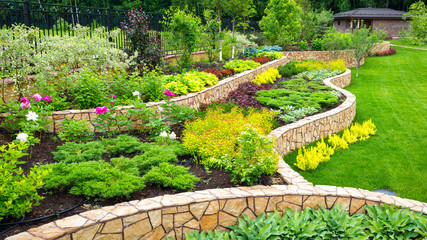It can be overwhelming if you want a beautiful garden for your home. It can be challenging to decide on a design because there are many factors to consider, such as the color theme, scale, and material. Here are some tips that will help you get started. Read this article to understand what makes a great landscape design. Once you have the basic elements of a great garden, you can design the plants and hardscapes.

The engineering role of plants is an important factor in the overall success of the plantings. In addition to providing color, plants can also serve as an engineering tool. Their bark, leaves, and flowers can add texture to a landscape. Plants can function correctly as a buffer between divergent activities or create a more functional space. These design elements can also be used to create special habitats for birds and other wildlife.
Planting plants in a landscape should follow layering principles and repetition. Similar individual plants should be planted close to one another to create a strong interface. A repeating pattern can also be visually effective, especially if it includes different plant types. Whether using flowers, shrubs, or trees, the first step in organizing plants is to plan the placement of each type. In addition to laying out the individual plants, remember to space them, so they touch each other once fully mature.
Using hardscapes in landscape designs has several benefits, both aesthetic and functional. A landscape with effective hardscapes will be more inviting to visitors and can enhance the space by enhancing the soft aspects of the garden or lawn. Before starting to create your new hardscapes, it is important to consider the climate in your area. Arid climates, for example, will require different strategies than tropical ones.
Choosing the right hardscaping materials can significantly impact future maintenance needs. Properly chosen hardscaping will help guard against weeds and maximize the greenery year-round. With more sophisticated tools and materials, the landscaping industry can include new, environmentally friendly hardscape materials to increase the aesthetic appeal of your outdoor space. For instance, some new hardscaping materials are alive, while others are inert and will not require watering.
The scale of landscape designs can be achieved by comparing the size of elements to their surroundings. There are two types of scales, the absolute and relative. The relative scale creates a relaxed, peaceful environment. The large scale promotes action and is usually used around large buildings and areas. The absolute scale is the opposite of the relative scale and is used when a space needs to fill a lot of space. However, if the area is confined, it can be made smaller by utilizing a low scale.
In landscape designs, color and texture can delineate different spaces. The visual weight of the spaces creates a hierarchy, and areas of high importance should have features that draw attention. In addition to visual weight, the scale can help determine the types of landscape features. For instance, different uses require different square footage. By contrasting two types of scales, the viewer can easily discern which is important and which isn’t.
In designing a landscape, the designer will first consider the needs of the users and the site conditions. Once a site has been chosen, the designer will organize hardscape materials and plant material into the desired layout. The most basic of the composition elements is line, which is used in various ways in landscape design. There are many different visual qualities of a space, such as harmony or visual weight. These qualities will be present in the landscape and help people enjoy the space.
Adding texture to your landscape design is a great way to create interest. Many people prefer plants with unique textures, as it will give them a reason to touch and look around. Different textures to your plants will add visual interest and give your garden a richer look. In addition, some textures are also useful for environmental benefits, as they can intercept air pollution and act as a filter. The important thing to remember when adding texture is to keep things in balance, as too much can be boring.
When choosing the texture in your landscape design, you should keep the first sense in mind. The eye is the most important sense when designing a landscape, so consider your landscaping accordingly. Mix fine and bold foliage to create visually stunning textured designs. Use amorphous and graphic plants together. Remember that textures don’t have to look cluttered – repetition can keep the space looking clean and uniform. However, if you are trying to add a lot of texture to your landscape design, choose a single texture that will work best for you.